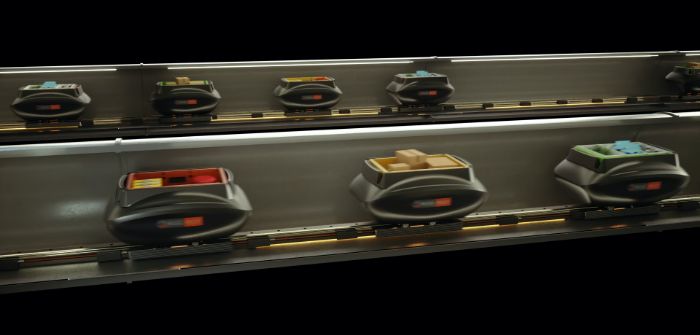As supermarkets rolled out strategies, such as hiring more staff and increasing the use of in-store production facilities in an effort to ‘feed the nation’ at the start of the COVID-19 pandemic, the vulnerability of the UK’s supply chain was very quickly uncovered.
Short-term supply issues of essentials, such as toilet paper, pasta and fresh vegetables, revealed the precarious nature of how unexpected demand can affect the modern-day, ‘just-in-time’ supply model operated by today’s modern stores.
The problem was not that warehouses and distribution centers experienced a shortage of goods; the issue was due to capacity constraints both within the warehouse and most notably the way we transport goods – something that has not changed in over 100 years.
With adequate stock in the supply chain, the challenge for supermarkets, as well as other retailers that experienced a spike in online sales, was how to replenish shelves and pick and deliver goods quickly enough to meet the huge and sudden increase in demand both in store and online.
A report from Kantar into UK consumer shopping behavior during the early stages of the pandemic revealed that, rather than bulk buying and hoarding items, shoppers simply added a few more products to their baskets, and made more frequent visits. With restaurants closed, there were also more people buying food instead of eating out. An additional 15 million trips to UK supermarkets were made in the week ending March 17, compared to the week ending February 17.
The knock-on effect within the supply chain was that online distribution centers operating ‘just-in-time’ stock levels ran low as customers placed larger orders. Elsewhere, store distribution centers struggled to accept more stock because they were unable to transport it into the supermarkets quickly enough. During this time, we witnessed shelves emptying faster than they could be replenished.
Online, but not on time
All the UK’s major supermarkets experienced serious delays in fulfilling online delivery orders. Ocado admitted that it had experienced more demand for products and deliveries than it could meet, comparing the increase in traffic to its website to a denial of service attack.
Despite advances in retail technology, the supermarket supply chain involves a high degree of manual complexity which, if automated, could avoid some of these recent retail supply issues experienced throughout the UK.
There is the challenge of transporting millions of individual items to people’s homes using fleets of delivery vans and articulated vehicles while there is a shortage of heavy goods vehicle drivers. According to news from the Freight Transport Association (FTA), this shortage climbed to almost 60,000 in 2019; 60% of drivers were over the age of 44 years and 64% of transport and storage businesses reported facing severe skills shortages.
Next, there are staffing issues. Manual pickers are only able to work a limited number of hours to fulfil online customer orders. Of course, it’s possible for more employees to be hired, but a pandemic of this nature, with increased levels of illness, strict isolation measures and simply less factory space available as safe social distancing measures are put in place, throws up further challenges.
Finally, once orders are completed, they must then be physically loaded onto delivery vans while ensuring fresh, chilled and hazardous produce is carefully segregated – a time consuming and labor-intensive procedure.
To help alleviate this problem, Magway has a clear vision for the future of parcel deliveries. Each Magway system has the potential to transport more than 600 million packages and parcels a year. This equates to two 40ft articulated lorries worth of goods moving through the system every minute. Travelling at an optimal speed of just over 30mph, totes would take around 40 minutes to arrive. Scale this operation up across the UK, Magway could potentially handle billions of parcels and packages every year.
We already have senior level engagement with online retailers and logistics companies and believe Magway can accommodate all the goods delivered by UK online grocers and 90% of online general merchandise goods purchased from the likes of Amazon. If we just look at London for example, our analysis has shown that 94% of London’s daytime population could be within a 15-minute walk or cycle of a Magway node. If the expected benefits can be validated, a full-scale roll-out could eliminate millions of tons of CO2 emissions annually, save millions of pounds worth of road maintenance costs and transform our road networks.
Although not in place to assist with the challenges during this current health crisis, a sustainable transportation solution comprising a network of underground pipes – a sort of ‘physical internet’ – used to transport goods and services, including essential items, such as medical supplies for example, could help solve the capacity constraints and resilience issues which have been exposed in today’s logistics supply chain.
The future of sustainable transportation solutions
As our transportation system begins its own transformation in efforts to reduce air pollution, there will be changes to the logistics supply chain in a post-pandemic world. Currently goods are transported 30 to 50 miles to consumers’ doors. However, Magway will aim to bring those goods much closer to within five miles of the destination. This will enable cleaner modes of transportation for the final leg, including cycle, click and collect, and autonomous and electric vehicles.
We are aiming for construction work to start in around 2023 on what we hope will be the first of several longer routes of up to 60 miles that will ultimately form a network of delivery pipes connecting the UK.
Increased automation of how goods are moved from shelves to trucks and ultimately delivered to consumers has never been more important. Being able to move goods to consumers in a safe and more efficient manner that involves reduced manual intervention would help mitigate risk from global disasters such as the current pandemic, while also having a positive impact on the environment.


